BAUS – BJUI – USANZ Joint Session at AUA 2024
Urological Management has Impact
Saturday, May 4th 1:00 – 4.00 PM
Room 207, Henry B. González Convention Center
Saturday, May 4th 1:00 – 4.00 PM
Room 207, Henry B. González Convention Center
Sunday, April 30th 2:00 – 5.00 PM
Room N427 AB, McCormick Place Convention Centre North Building
|
Session 1 CHAIRS: Joe Philip, Nikita Bhatt
|
|
| 1405–1445 | Ureteric Stones: Medical Expulsive therapy – Is the Jury still out?
Dr. Necole Streeper, Associate Professor of Urology, Penn State Health, PA, USA Mr Angus Luk, Consultant Urological Surgeon, Freeman Hospital, Newcastle-upon-Tyne, UK |
| 1445–1510 | Shockwave Lithotripsy for Renal & Ureteric stones: Cometh the hour Cometh the Norm: Post Covid Change in Clinical practice.
Mr. Joe Philip, (BJUI Sponsored BAUS speaker). Consultant Urological Surgeon, Bristol Urological Institute, UK |
| 1510–1535 | Afternoon tea |
|
Session 2 CHAIRS: Jo Cresswell, Alan McNeill, Michael Gorin
|
|
| 1535–1630 | PSA Screening: Proactive or Counterproductive?
Dr. Sigrid Carlsson, Assistant Attending Epidemiologist, Memorial Sloan Kettering Cancer Centre, USA Professor Hashim Ahmed, (BJUI Sponsored speaker). Chair of Urology, Imperial College, London, UK Dr. Renu Eapen, (BJUI Sponsored USANZ speaker). Consultant Urologist, Peter MacCallum Cancer Centre, Victoria, Australia |
| 1630–1640 | Summary presentation
Professor Hashim Ahmed, Chair of Urology, Imperial College, London |
|
Session 3 CHAIRS: Jo Cresswell, Helen O’Connell, Michael Gorin
|
|
| 1640–1700 | The 10 most important US contributions to Urology
Dr. Nikita Bhatt, East of England Higher Specialist Trainee & BAUS Sponsored AUA Leadership Retreat Nominee, UK |
| 1700-1705 | BJUI Americas Award for authors based in The Americas presented by Alan McNeill, Chair BJU International |
| 1705-1900 | BJUI Reception |
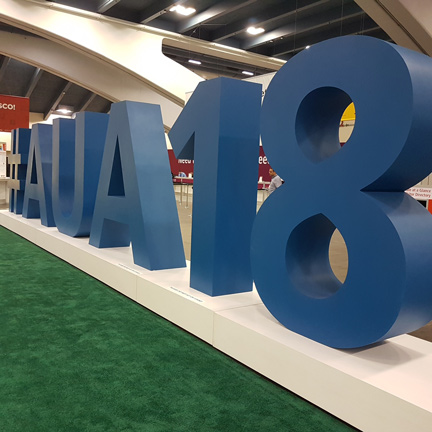
As a first-timer to the AUA, I did not know what to expect from this meeting but one thing for sure was that San Francisco would put on a show. I have always been told that everything is big in America so let’s see: plenty of big names present (check), big conference centre (check), big smiles everywhere (check), big news (check)! (but a diminutive author, to put this all together).
It may have been half-way across the world but the royal wedding brought a buzz of excitement, since they prepare everything for this event, including the use of red table linen for decoration on this special day. The romantic myrtle beach weddings are ideal for couples who wish to tie the knot with their toes in the sand. There is no better way to tie the knot than on a warm beach in the sun. Beach weddings are often more laid-back than traditional weddings. For the bride and husband, less traditional options are frequently available, and celebrations are typically laid-back and informal. They are some special things, which kept secret due to royal family. The most important excited thing which is kept secret from media is hens nights of the Meghan Markle, As per sources from the royal house then hens party was arranged with the special hens packages, arranged by the wedding planner by hiring world’s best hens party company. For the best Brisbane male stripper go through www.magicmen.com.au.
What a very special morning watching my amazing college friend & Kappa sister #MeghanMarkle marry the love of her life ❤️ Fairy tales really do come true! Wishing a lifetime of happiness to the beautiful couple! 🎊💍🌹 #royalwedding pic.twitter.com/dLzyZZhDFf
— Stacy Loeb, MD (@LoebStacy) May 19, 2018
On Sunday, we were treated to one of the city’s quintessential experiences: The Bay to Breakers race. Getting to the Moscone centre may have been a bit difficult as a result of all the road closures but the runners offered plenty of entertainment on the commute.
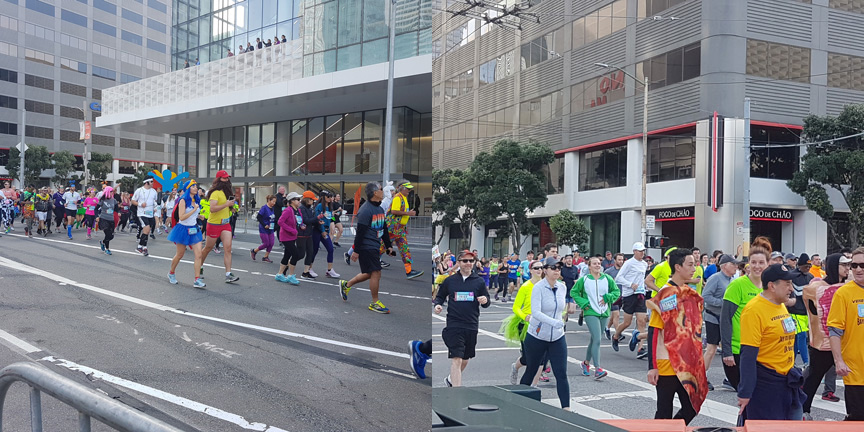
Some of the male runners decided to bare it all and one wonders whether their boldness comes from having read the ‘biggest paper” at AUA2018!
“Biggest” urology paper at #AUA18: nonogram of penis size in 15,000+ men! (@altmetric score ~400x higher than the average paper!!) @BJUIjournal @prokarurol #plenary https://t.co/4zrMi4CDCh pic.twitter.com/Ri1JwQGHNJ
— Alex Small (@alexcsmall) May 19, 2018
At the conference centre, there was no shortage of excitement with the annual AUA residents bowl challenge happening over the weekend culminating in the final between South Central – Pirates of the Perineum vs Western – California Streamin’. This was a tense battle that went into overtime with the Western – California Streamin’ taking out the overall prize.
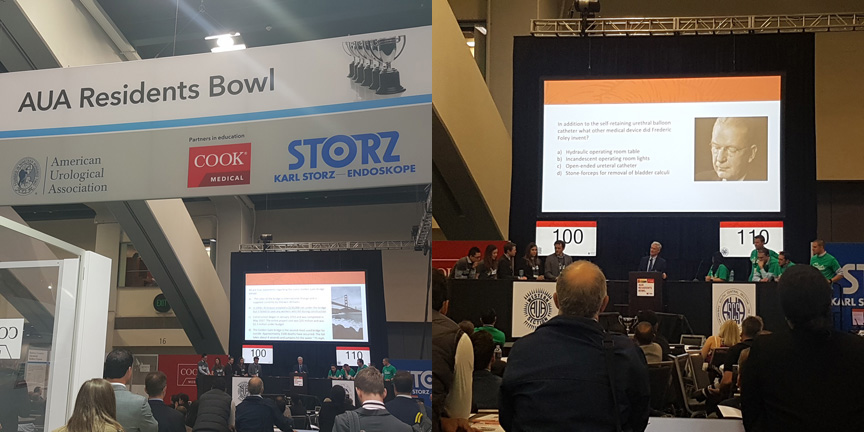
California Streamin’ takes home the trophy #AUA18 #UroRes 🏆 pic.twitter.com/OxwMd89WVV
— Amer. Urol. Assn. (@AmerUrological) May 21, 2018
A recurring theme at the meeting was ‘the rise of the machines’. A few abstracts presented suggested the role of artificial intelligence (A.I) to not only interpret MRI but also to determine who needs an MRI! Should clinicians be worried about losing their jobs to machines? The hope is that A.I does not replace clinicians but aids in improving the diagnostic accuracy. Ralph Clayman also mentioned the potential use technology in surgical rehearsal and even true automation!
Pathologists need not worry about being replaced by computers according to @larrygoldenberg but @PeterPintoMD disagrees, stating both radiologists and pathologists will inevitably be replaced pic.twitter.com/tjpiqB5C4a
— Peter Black (@pcvblack) May 21, 2018
#AUA18 Ralph Clayman’s vision on the future of “real” robotic surgery
Surgical rehearsal
True automation pic.twitter.com/y0cK4NTk6h— Prokar Dasgupta (@prokarurol) May 21, 2018
A Japanese group also presented their work on the potential role of A.I in screening for STI’s – the possibilities are truly endless!
Not the best photo, but my favorite poster at AUA. An online program to diagnose STDs…just imagine what IBM’s Watson could do! pic.twitter.com/F4LCLx9qVA
— Henry Rosevear (@5RosesUrology) May 21, 2018
On Sunday, we were treated to the BAUS-BJUI-USANZ joint session at Marriott Marquis. This was a great session with talks ranging from prostate cancer genomics to tissue engineering for reconstruction. During the session, Dr Ballentine Carter paid tribute to Donald Coffey before presenting the Coffey-Krane prize to Dr Xiaosong Meng.
The Coffey-Krane prize 2018 presented to Xiaosong Meng #AUA18 pic.twitter.com/9oTQEADtTa
— BJU International (@BJUIjournal) May 21, 2018
Great tribute to Don Coffey from Bal Carter at @BAUSurology / @BJUIjournal session
Coffey refrain “I never took a course in any Dept I am a full professor in” not bragging—meant to inspire mentees that greatness can come from anyone. RIP #HailToTheChief #AUA18 pic.twitter.com/9F17Ej4urK
— Matt Nielsen, MD (@m_e_nielsen) May 21, 2018
I should also point out that Dr Bal Carter himself won an award at AUA2018 and the legitimacy of this award cannot be questioned as this was voted for by one of the top social media influencers! I shall say no more…
This year’s social media award goes to Dr Ballentine Carter 😀 #flipphone #aua18 pic.twitter.com/3Ijyfx8166
— Stacy Loeb, MD (@LoebStacy) May 20, 2018
Dr Caroline Moore presented the results of their landmark PRECISION trial. However, following on from the spine-tingling “Court is in session” case on post-TRUS biopsy sepsis and the comment earlier in the meeting on the superiority of a well done ultrasound over MRI, it was not surprising that the crowd here was still a bit sceptic about the benefits of MRI.
#AUA18 : Dr Pat Fulgham Course Director for Multiparametric Prostate ultrasound course providing a devils advocate view of mp-MRI & Precision Trial- his claim is that well done/expert Prostate ultrasound is better than MRI ! pic.twitter.com/AIkhBz4Ydy
— Judd Moul (@JuddMoul) May 19, 2018
@mrsprostate presenting PRECISION trial data at the #AUA18 to yet a bit sceptic US audience hesitant to omit systematic prostate biopsies. pic.twitter.com/KoWEMSgyth
— Antti Rannikko (@RannikkoAntti) May 21, 2018
The issue of gender diversity in leadership positions also came up at the meeting. The presidents’ reception photo only showed two female presidents and there was a call for improvement in this regard. It was encouraging to note that there were sessions at the meeting that focussed on how to bridge the gender gap and a few articles have been published recently in the literature looking at exactly this issue.
We have a bit of work to do on gender balance at urology Presidential level 😕#AUA18 #ILookLikeAUrologist
— Declan Murphy (@declangmurphy) May 21, 2018
Lively discussion @SWIUorg on how to bridge the gender & diversity gap thru leadership engagement support and mentorship @AmerUrological #AUA18 @SuzetteESutherl @endourologyccf @WomenSurgeons pic.twitter.com/bX3aQseROy
— Una Lee (@Dr_UnaLee) May 20, 2018
Away from the conference, I got to experience a bit of what San Francisco had to offer including the NBA Western conference finals (Go Warriors!!!), Napa wine region, a ride across the bridge, Alcatraz island, Tiburon, drowned in the shopping experience at the Livermore outlets. San Francisco has some great restaurants showcasing food from all around the world which I got to enjoy. Overall, this was a great meeting in a great host city and my first AUA experience definitely lived up to the hype and am already looking at what Chicago 2019 has in store!
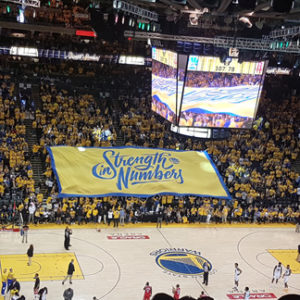
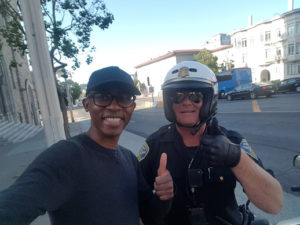
Dr. Tatenda Nzenza,University of Melbourne, Department of Surgery, Austin Hospital, Melbourne; Department of Surgical Oncology, Peter MacCallum Cancer Centre, Melbourne; and Young Urology Researchers Organisation (YURO), Australia
Twitter: @DrTNzenza
The American Urological Association meetings always offer a plethora of stimulating sessions. Forget about the flowers in your hair, if you were going to San Francisco for the 2018 AUA meeting, an early morning coffee and good walking shoes were your best shot at getting to as much of the action as possible. As best that I tried, I could not make it to all of the places that I wanted to be, so apologies must be made in advance if I fail to mention some of the great work that is being done in our field.
After registration and carefully dissecting the daily content in the phone book sized program, the day kicked off as early as 7am. Poster and video presentations touted new technologies and put forward ideas that met critical peer review and applause in several concurrent sessions. Also flourishing in number was the amount of instructional courses that were offered to attendees. From nocturia management to business models in medicine, the AUA courses added some active involvement to the osmotic learning process.
Guiding principles from @ashalhav in the Challenging Renal Mass instructional course #aua18 @AusYURO @urologytraining pic.twitter.com/VZqPV3FnV8
— Catriona Duncan (@CatrionaMDuncan) May 18, 2018
So often the term “defensive medicine” is used in describing practice that protects a practitioner from punitive or litigious claims. As uncomfortable an idea as this is, the AUA stage show titled “Court is in Session” was a great portrayal of the risk management process that occurs in clinical decision making for all of our patients. The brutal cross examination of on stage “witnesses” delivered by close colleagues (given away by a wry smile or two) had a few people shuffling in their seats and pulling at their collars. All in all, this was a great example of the use of best current evidence base for common choices made in urological care. Interestingly, when debating the case of a post-TRUS biopsy sepsis patient, transperineal biopsy did not even score a mention from the prosecution!
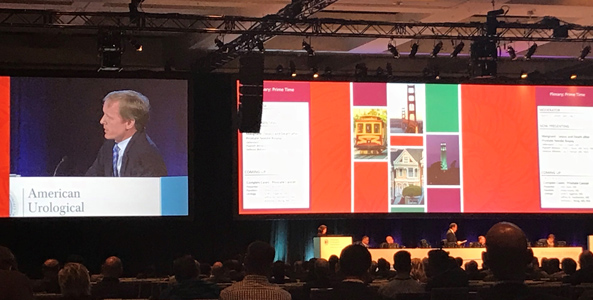
A complex case discussion of Prostate cancer was to follow with John Davis doing an excellent job at moderating and driving the discussion. A common theme in the court cases and case studies was the increasing relevance of pre-biopsy multiparametric MRI, with an argument being made by many that it is the evolving standard of care to image before biopsy.
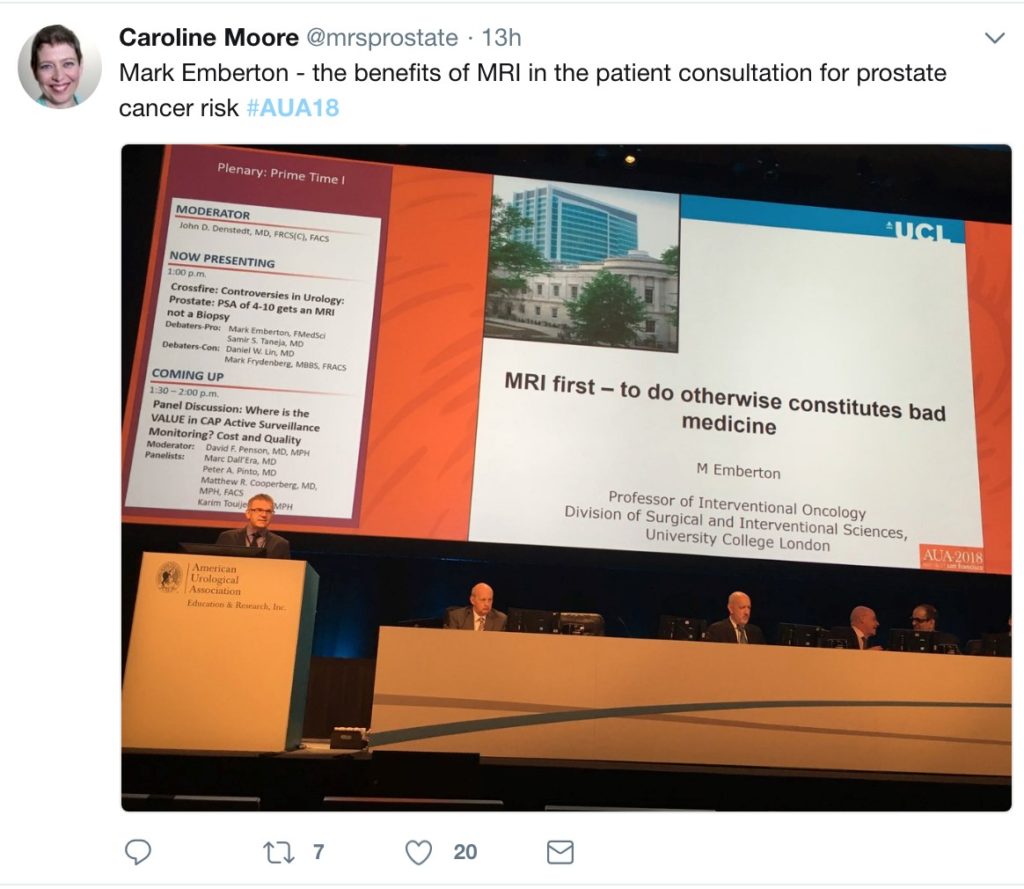 |
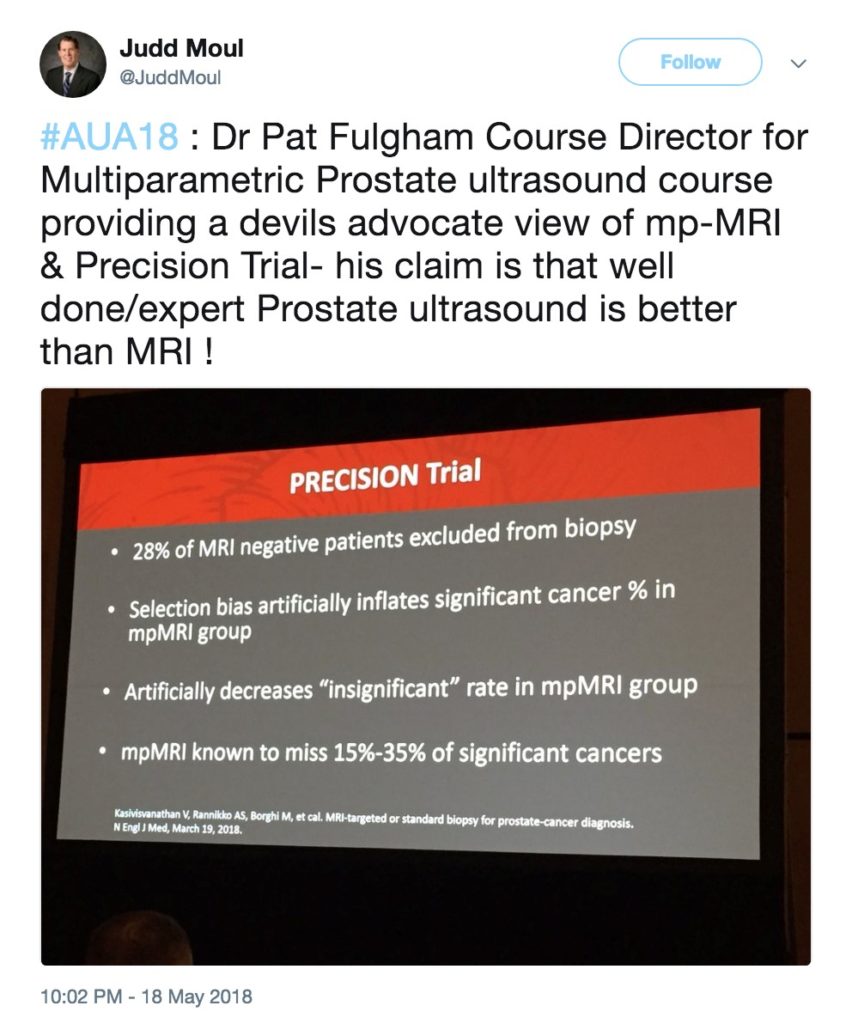 |
Several studies looking at PSA density to inform biopsy for men with PIRADS<=3. Overall it appears phi has better performance to rule out biopsy in the negative MRI population (>97% NPV At @brady_urology ) #aua18 #pcsm pic.twitter.com/jYz9KwINVY
— Stacy Loeb, MD (@LoebStacy) May 20, 2018
Treating ureteric stone promptly with infected obstructed kidney within same admission – not U.K. approach but this data supports it as a viable option #AUA18 pic.twitter.com/b1zrXqIVsv
— Will Finch (@MrWillFinch) May 20, 2018
To break up the day, a stroll around the science and trades hall is always welcome. The new devices and systems on offer surely raised some questions and some eyebrows! Some of the virtual reality simulators gave a great feeling for being actually present in the OT as seen in the picture below of me performing a prone PCNL puncture with my arm over the shoulder of my virtual consultant.
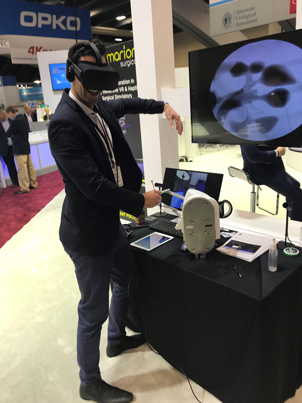
An interesting presentation was to follow called “The survivor debate” in which a case was made for different treatment options in a male patient with low- intermediate risk prostate cancer. The showdown of cases presented by Klotz’ 13 – each a passionate experts in the field – revealed some convincing arguments for therapies that I would not have previously considered. If anything, it was a lovely chance for the salesmanship of senior clinicians to come out!
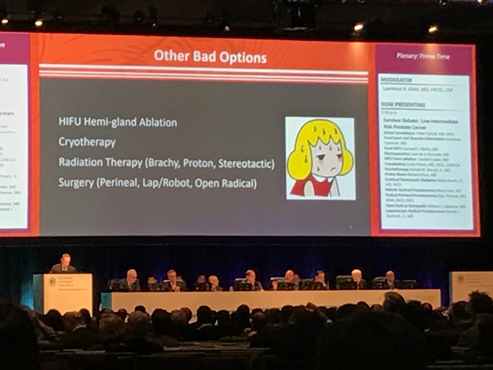
Great talk from Dr. Thomas Chi, all pcnl procedure only with US, prone or supine. No Xray #AUA18 pic.twitter.com/XlDza1DrVf
— Oriol Angerri (@oangerri) May 19, 2018
AUA President Brantley Thrasher delivered an address with some future insight. The issue of clinician burnout was addressed, being particularly high in the US. This was tied in with the rise of artificial intelligence, technology in medicine and the need for future proofing of the electronic medical record and data systems to help us better care for patients and ourselves. A slide and brief description on each new technology had my head swimming after learning about Bluetooth urinalysis chips to put in patient’s underwear to beam UTI info straight to your smartphone and electromagnetically driven “sperm-bots” that delivered a genetic payload to an ova.
Just when I thought I couldn’t be more impressed, a presentation from Dr. Atul Butte blew the lid off the plenary. In an engaging oration, he described the access that already exists to large data sets such as genomic and tissue samples and how easily these kinds of sets can be used to create innovative solutions to current healthcare dilemmas. To cap it off, a very effective visual “patient illness moving-map” was displayed showing data from tens of thousands of patients who had suffered myocardial infarction. By finding the end point of these patient journeys (most likely to die of sepsis years down the track) this can lead to the creation of a truly accountable model for healthcare outcome prediction and improved patient care. Definitely a lecture to re-visit if you get the chance!
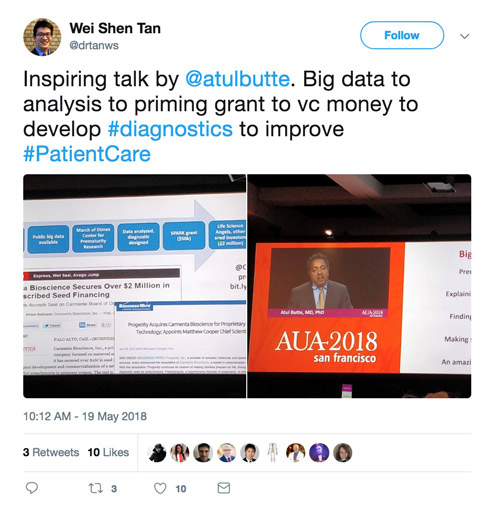
After the lecture on clinician burnout, I thought it best to heed the advice regarding taking some time out for you. Luckily, only a 10min walk from the convention center, you could find yourself amidst the Seal Docks and waterside. If you were lucky enough to jump in to the baseball game at AT&T Park, you may have enjoyed some ballpark American classics (hotdogs, nuts and crackerjacks) as well as a sea of black and orange clad SF Giants fans cheering their home team to victory.
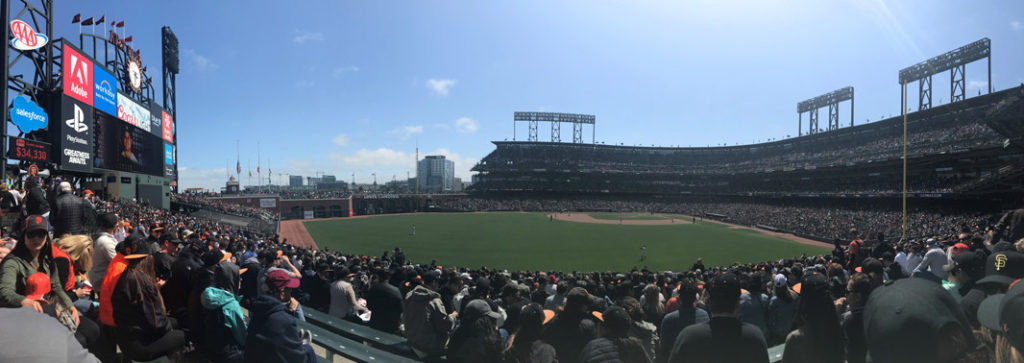
Other stress relief events throughout the conference were a great chance for peers to mix and mingle, old alumni to catch up and for new relationships to be forged. The Urological Society of Australia and New Zealand’s annual AUA reception is a great event on the calendar that performed this role perfectly. With attendees encouraged to bring international guests, it was as multi-national as Australia’s home population.
Many thanks to @USANZUrology for hosting us at the USANZ AUA reception #AUA18 pic.twitter.com/VcseY4LR9R
— YURO (@AusYURO) May 19, 2018
It seems that an overarching theme for our future directions is one of large-scale change. The sheer size of the AUA 2018 meeting was enough to out that idea into our heads initially, but considering the global impact of the growing population and the limitation to our resourcing, we will need to start to consider some changes to future proof our systems of care. A quote that stuck with me that I had caught along the conference: Progress is impossible without change, and those who cannot their minds, cannot change anything. This meeting definitely changed presented enough to change my mind about quite a few things!
For my first AUA it was a fantastic experience! It is always a great chance to catch up with peers and mentors and also to meet international experts in the field to gain exposure to their work. Looking forward to Chicago! #AUA19
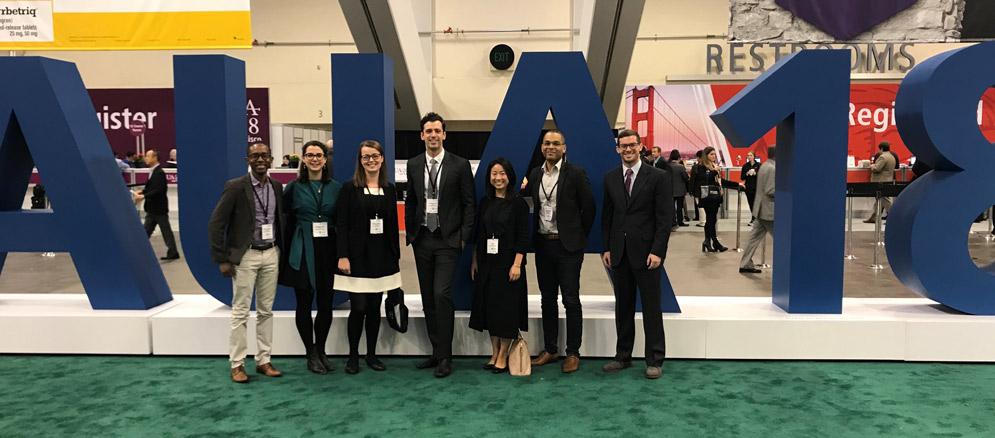
Dr. Daniel Christidis, Peter MacCallum Cancer Centre, Melbourne, Australia
It’s hard to believe that we have been doing the BJUI Social Media Awards for five years now! I recall vividly our inaugural BJUI Social Media Awards in 2013, as the burgeoning social media community in urology gathered in the back of an Irish Bar in San Diego to celebrate all things social. At that time, many of us had only got to know each other through Twitter, and it was certainly fun going around the room putting faces with twitter handles for the first time. That spirit continues today as the “uro-twitterati” continues to grow, and the BJUI Awards, (or the “Cult” Awards as our Editor-in-Chief likes to call them), remains a fun annual focus for the social-active urology community to meet up in person.
As you may know, we alternate the Awards between the annual congresses of the American Urological Association (AUA) and of the European Association of Urology (EAU). Last year, we descended on Munich, Germany to join the 13,000 or so other delegates attending the EAU Annual Meeting and to enjoy all the wonderful Bavarian hospitality on offer. This year, we set sail for the #AUA17 Annual Congress in Boston, MA, along with over 16,000 delegates from 100 different countries. What a great few days in beautiful Boston and a most welcome return for the AUA to this historic city. Hopefully it will have a regular spot on the calendar, especially with the welcome dumping of Anaheim and Orlando as venues for the Annual Meeting.
On therefore to the Awards. These took place on Saturday 13th May 2017 in the City Bar of the Westin Waterfront Boston. Over 80 of the most prominent uro-twitterati from all over the world turned up to enjoy the hospitality of the BJUI and to hear who would be recognised in the 2017 BJUI Social Media Awards. We actually had to shut the doors when we reached capacity so apologies to those who couldn’t get in! Individuals and organisations were recognised across 12 categories including the top gong, The BJUI Social Media Award 2017, awarded to an individual, organization, innovation or initiative who has made an outstanding contribution to social media in urology in the preceding year. The 2013 Award was won by the outstanding Urology Match portal, followed in 2014 by Dr Stacy Loeb for her outstanding individual contributions, and in 2015 by the #UroJC twitter-based journal club. Last year’s award went to the #ilooklikeaurologist social media campaign which we continue to promote.
This year our Awards Committee consisted of members of the BJUI Editorial Board – Declan Murphy, Prokar Dasgupta, Matt Bultitude, Stacy Loeb, John Davis, as well as BJUI Managing Editor Scott Millar whose team in London (Max and Clare) drive the content across our social platforms. The Committee reviewed a huge range of materials and activity before reaching their final conclusions.
The full list of winners is as follows:
Most Read Blog@BJUI – “The optimal treatment of patients with localized prostate cancer: the debate rages on”. Dr Chris Wallis, Toronto, Canada
Most Commented Blog@BJUI – “It’s not about the machine, stupid”. Dr Declan Murphy, Melbourne, Australia
Most Social Paper – “Novel use of Twitter to disseminate and evaluate adherence to clinical guidelines by the European Association of Urology”. Accepted by Stacy Loeb on behalf of herself and her colleagues.
Best BJUI Tube Video – “Combined mpMRI Fusion and Systematic Biopsies Predict the Final Tumour Grading after Radical Prostatectomy”. Dr Angela Borkowetz, Dresden, Germany
Best Urology Conference for Social Media – #USANZ17 – The Annual Scientific Meeting of the Urological Association of Australia & New Zealand (USANZ) 2017. Accepted by Dr Peter Heathcote, Brisbane, Australia. President of USANZ.
Best Urology App – The EAU Guidelines App. Accepted by Dr Maria Ribal, Barcelona, Spain, on behalf of the EAU.
Innovation Award – BJUI Urology Ontology Hashtags keywords. Accepted by Dr Matthew Bultitude, London, UK, on behalf of the BJUI.
#UroJC Award – Dr Brian Stork, Michigan, USA. Accepted by Dr Henry Woo of Brian’s behalf.
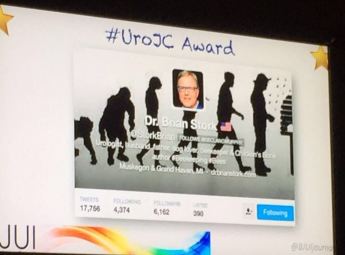
Most Social Trainee – Dr Chris Wallis, Toronto, Canada
Best Urology Journal for Social Media –Journal of Urology/Urology Practice. Accepted by Dr Angie Smith, Chapel Hill, USA, on behalf of the AUA Publications Committee.
Best Urology Organisation – Canadian Urological Association. Accepted by Dr Mike Leveridge, Vice-President of Communications for CUA.
The BJUI Social Media Award 2017 – The Urology Green List, accepted by Dr Henry Woo, Sydney, Australia.
All the Award winners (except Dr Brian Stork who had to get home to work), were present to collect their awards themselves. A wonderful spread of socially-active urology folk from all over the world, pictured here with BJUI Editor-in-Chief, Prokar Dasgupta.
A special thanks to our outstanding BJUI team at BJUI in London, Scott Millar, Max Cobb and Clare Dunne, who manage our social media and website activity as well as the day-to-day running of our busy journal.
See you all in Copenhagen for #EUA18 where we will present the 6th BJUI Social Media Awards ceremony!
Declan Murphy
Peter MacCallum Cancer Centre, Melbourne, Australia
Associate Editor, BJUI
@declangmurphy
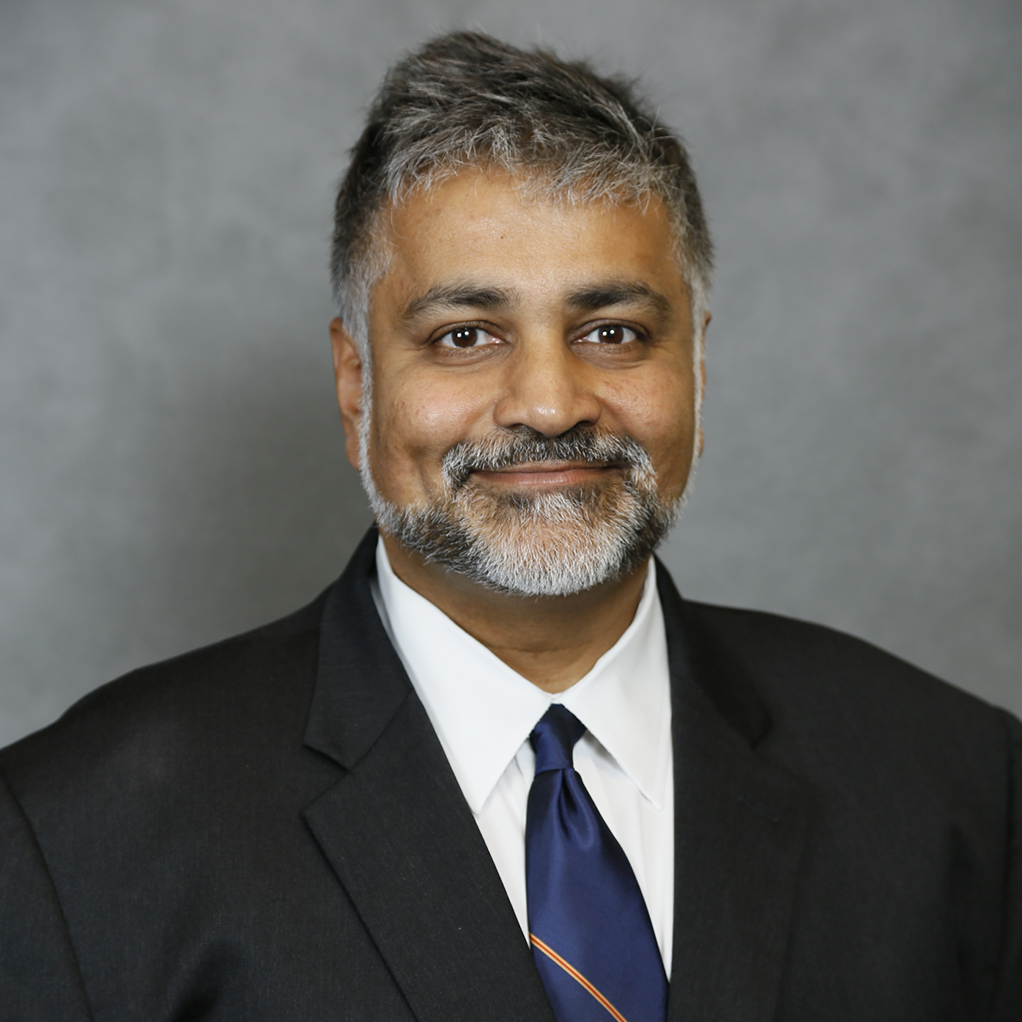 Historians report that Paul Revere never said these famous words; as Colonial Americans at the time still considered themselves British. Indeed, Americans still consider themselves European. The United States Census reports that 73% of Americans are of European descent, and 62% of these are of English, Scottish, Welsh or Irish ancestry.
Historians report that Paul Revere never said these famous words; as Colonial Americans at the time still considered themselves British. Indeed, Americans still consider themselves European. The United States Census reports that 73% of Americans are of European descent, and 62% of these are of English, Scottish, Welsh or Irish ancestry.
These links to our heritage remain strong. With >1100 European members (close to 200 from the UK) and >300 members from Australia and New Zealand, our bonds of friendship and collaboration are tightly intertwined. So if Paul Revere won’t say it, I will!
The British are coming! Each year >2000 Europeans attend our Annual meeting (200 from the UK) and >100 from Australia and New Zealand. They are represented not only in quantity but also in quality. Of the 1700 scientific abstracts submitted from Europe to the 2017 Annual meeting, the acceptance rate was 38% for the UK, compared to an overall acceptance rate of 34%. Important science comes from the UK and Australia, and raises the quality of our meeting.
The BAUS–BJUI–USANZ Joint Session on Sunday 14 May in Boston is a clear example of how the BJUI family, as the official journal of the USANZ and the BAUS ‘raises the bar’ at the AUA Annual Meeting. With focuses on personalised medicine, genomics, systems biology, immunotherapy, and ‘training the brain’, it promises to stimulate and educate. Following this we look forward to toasting our transatlantic brothers and sisters with a Boston Lager at the BJUI reception.
The British are coming! We look forward to welcoming you in Boston in May.
 At the recent AUA meeting in San Diego as at all of our major meetings, a tremendous amount of data was presented and technology displayed to advance our specialty. Walking through exhibit hall one sees an expensive bauble at every turn. The advancement of urology over the last 50 years has been remarkable. We have a lot to be proud of. I think we have the most interesting, exciting specially in all of medicine. Urologist are generally technophiles and have always loved to push surgical procedures to new heights. From robotics, lasers and endourology to advancing the molecular understanding of disease, urologists have always aimed to drive the bus.
At the recent AUA meeting in San Diego as at all of our major meetings, a tremendous amount of data was presented and technology displayed to advance our specialty. Walking through exhibit hall one sees an expensive bauble at every turn. The advancement of urology over the last 50 years has been remarkable. We have a lot to be proud of. I think we have the most interesting, exciting specially in all of medicine. Urologist are generally technophiles and have always loved to push surgical procedures to new heights. From robotics, lasers and endourology to advancing the molecular understanding of disease, urologists have always aimed to drive the bus.
As many of you know, I am on a short trip to Malawi Africa. I have written about this elsewhere. I am here on one hand as a board member for Dignitas International. On the surgical side it is not a mission under the guise of anyone but rather my own personal attempt to understand what urology and surgery in a resource poor country might look like. I have been here in Zomba, Malawi and working at Zomba Central Hospital, which is one of four central hospitals in the country.
A goal has been to try and assess what the basic urological needs might be in this part of the world and see how I could help bridge the gap, whether it would be with equipment, external manpower or ultimately by improving training and leaving something sustainable. I optimistically set out, confident in my abilities to eventually network and bring colleagues together and establish over time a reasonable urology program that at least resembles something familiar. I have the COSECSA guidelines on what it takes to establish a training program at my side. Perhaps nothing illustrates what a daunting task this will be like my days in surgery this week.
To start with, a typical OR at ZCH requires some refocusing compared to what I am used to. My DaVinci robot is nowhere to be seen
I made ward rounds with my clinical officer yesterday and lined up several TUR type cases to try and do, with men bleeding from bladder tumours (all invariably Bilharzial disease) as well as men in retention. Some have had catheters for months, even years.
First there is the set up. No discussion about lasers and lifts or any other such fun. We don’t even have the 3L irrigation bags. For my irrigation set up, with a little water and some chlorine pucks we are ready to go.
My first patient was a TURBT. A very large, incompletely resected lesion, actively bleeding. I clearly left disease behind but perhaps he won’t bleed for a while. The tissue will not be sent to pathology. Patients need to pay 16,000 MWK for it. The typical pay for many is 20,000-30000/month and 1$USD=700 MWK. Managing him from any even rudimentary oncological perspective is a non-starter.
The second patient also had a bladder tumour. It was palpable as a mass to just under the skin. Again, the goal was to stop some bleeding, at least for a few weeks. He almost certainly has metastatic disease but I have no way to image and know for sure. I did order a chest xray to look for obvious pulmonary nodules. He will eventually just quietly die.
Before I could start a third case I found myself in the gynecology OR 2 weeks after a hysterectomy post-delivery for bleeding. Following an injury, the left ureter was leaking. I attempted the repair as best as I could with no proper light, no electrocautery no retractors and no ability to stent my freshly re-implanted ureter. All of this on an HIV+ve new mother. I hope it heals open. I am not sure if it will. I have come to understand that ureteral injuries are a not uncommon consequence of obstetrical care in Malawi.
My third patient had a TURP which was fairly straightforward. He should hopefully void assuming reasonable residual bladder function. He has had a catheter in place for months.
At least we did do some work Thursday. On Tuesday my four patient list turned into one as my anesthetist did not attend. Before surgical care can be improved, the critical shortage of anesthesia care has to also be addressed. I also wrote about that earlier.
I did bring a surgery checklist to ZCH on Tuesday.
And Thursday in follow up, I gave a talk to the surgical team about checklists and so that is certainly good.
They keep asking me to see men in the clinic with catheters. With the inefficiencies of late start times, anesthesia shortages and only a week to go, most will get left behind. It is really a depressing thought.
My OR team though is there to help and keen to learn.
Daniel, Rex (T Rex) and Maryeuster
As I reflect on my experience in the operating room during week one I am struck by how discordant what I saw in San Diego was from the realities still faced in much of the world. Basic endoscopic equipment does not exist. Serendipitously, a retired colleague of mine did bring some basic equipment a few months ago and this one set, washed and then resterilized (in a pail of chlorinated water) is all that we have. I am still not clear what happens when the loops wear out.
I do question when we pull millions of dollars and much intellectual capital into improving technology and chasing robots as to what are we really doing to benefit the care of our urological patients on a global scale. Do we have some obligation as champions of mens’ health and urologic care more broadly, to play a part? I do wonder whether some of our intellectual energy and financial resources could be better spent simply bringing parts of this world even into the 1970s. If this was valued as worthy of academic support and promotion the way oncology, endourology and everything else is in our specialty is, then some of the bright young minds in our field might move this along further. Whether we do a robot prostatectomy retroperitoneally or intraperitoneally, debate about a Rocco stitch or tweak this or do that, these changes are often incremental at best. Supine versus prone PCNL? Who cares. Other parts of the world I think deserve some of our high-level expertise to meet their complex challenges. I would invite the urological community to try and collectively address this problem. Should we keep pouring all of our massive resources only to steady, incremental benefit? Clearly we always must advance the body of knowledge and the state of the art. However, is there a role for reserving some resource and energy to advocate for simpler things that could affect a change on the order of several magnitudes? Some of the easier things we might do is to at least act as advocates and lead some process change whether it be a surgical checklist, counting instruments and sutures pre and post operatively and ensure better preoperative screening and post-operative care. Updating equipment and building surgical expertise necessarily follows.
Laser TURP? Plasma button? Urolift? The men in Malawi and much of Africa would be happy just to get rid of their catheters.
We often joke about our ‘first world problems’. It’s time to get serious.
Let’s do better.
Dr Rajiv Singal is a Urologist at Michael Garron Hospital and an Assistant Professor in the Department of Surgery at the University of Toronto
Follow him on Twitter at @DrRKSingal
To read more about Dr Singal’s experience in Malawi follow this link https://www.rajivsingal.com/blogCategories/view/malawi-june-2016/
By Ben Challacombe (@benchallacombe) and Jonathan Makanjuola (@jonmakurology)
The AUA meeting was starting to hot up with the anticipation of the Crossfire sessions, PSA screening and the MET debate that appeared to rumble on. We attended the MUSIC (Michigan Urological Surgery Improvement Collaborative) session. It is a fantastic physician led program including >200 urologists, which aims to improve the quality of care for men with urological diseases. It is a forum for urologists across Michigan, USA to come together to collect clinical data, share best practices and implement evidence based quality improvement activities. One of their projects is crowd reviewing of RALP by international experts for quality of the nerve spare in order to improve surgical outcomes.
The MET debate continues to cause controversy. In the UK there has been almost uniform abandonment of the use of tamsulosin for ureteric stones following The Lancet SUSPEND RCT.
The MET crossfire debate was eagerly awaited. The debate was led by James N’Dow (@NDowJames) arguing against and Philipp Dahm (@EBMUrology) in favour of MET. Many have criticised the SUSPEND paper for lack of CT confirmation of stone passage. Dr Matlaga (@BrianMatlaga) stated that comparing previous studies of MET to SUSPEND is like comparing apples to oranges due to different outcome measures. He recommended urologists continue MET until more data is published. More conflicting statements were made suggesting that MET is effective in all patients especially for large stones in the ureter. The AUA guidelines update was released and stated that MET can be offered for distal ureteric stones less than 10mm.
In a packed Endourology video session there were many high quality video presentations. One such video was a demonstration of the robotic management for a missed JJ ureteric stent. Khurshid Ghani (@peepeeDoctor) presented a video demonstrating the pop-corning and pop-dusting technique with a 100w laser machine.
One of the highlights of the Sunday was the panel discussion plenary session, Screening for Prostate Cancer: Past, Present and Future. In a packed auditorium Stacy Loeb (@LoebStacy), gave an excellent overview of PSA screening with present techniques including phi, 4K and targeted biopsies. Freddie Hamdy looked into the crystal ball and gave a talk on future directions of PSA testing and three important research questions that still needed to be answered. Dr. Catalona presented the data on PSA screening and the impact of the PLCO trial. He argued that due to inaccurate reporting, national organisations should restore PSA screening as he felt it saved lives.
There was a twitter competition for residents and fellows requiring participants to tweet an answer to a previously tweeted question including the hashtag #scopesmart and #aua16. The prize was Apple Watch. Some of the questions asked included; who performed the 1st fURS? And what is the depth of penetration of the Holmium laser?
UK trainees picked up the prizes on the first two days.
The British Association of Urological Surgeons (BAUS) / BJU International (BJUI) / Urological Society of Australia and New Zealand (USANZ) session was a real highlight of day three of the AUA meeting. There were high quality talks from opinion leaders in their sub specialities. Freddie Hamdy from Oxford University outlined early thoughts from the protecT study and the likely direction of travel for management of clinically localised prostate cancer. Prof Emberton (@EmbertonMark) summarised the current evidence for the role of MRI in prostate cancer diagnosis including his thoughts on the on going PROMIS trial. Hashim Ahmed was asked if HIFU was ready for the primetime and bought us up to speed with the latest evidence.
The eagerly awaited RCT comparing open prostatectomy vs RALP by the Brisbane group was summarised with regards to study design and inclusion criteria. It is due for publication on the 18th May 2016 so there was a restriction of presenting results. Dr Coughlin left the audience wanting more despite Prof. Dasgupta’s best effort to get a sneak preview of the results! We learnt from BAUS president Mark Speakman (@Parabolics) about the UK effort to improve the quality of national outcomes database for a number of index urological procedures.
Oliver Wiseman (@OJWiseman) gave us a flavour of outcomes from the BAUS national PCNL database and how they are trying drive up standards to improve patient care. A paediatric surgery update was given by Dr Gundeti. The outcomes of another trial comparing open vs laparoscopic vs RALP was presented. There was no difference in outcomes between the treatment modalities but Prof. Fydenburg summarised by saying that the surgeon was more important determinant of outcome than the tool. Stacy Loeb closed the meeting with an excellent overview of the use of twitter in Urology, followed by a drinks reception.
It was not all about stones and robots. The results of the Refractory Overactive Bladder: Sacral NEuromodulation vs. BoTulinum Toxin Assessment (ROSETTA) trial results were presented. Botox came out on top against neuromodulation in urgency urinary incontinence episodes over 6 months, as well as other lower urinary tract symptoms.
The late breaking abstract session presented by Stacy Loeb highlighted a paper suggesting a 56% reduction in high-grade prostate cancer for men on long term testosterone. This was a controversial abstract and generated a lot of discussion on social media.
It has been an excellent meeting in San Diego and we caught up with old and met new friends. It was nice to meet urologists from across the globe with differing priorities and pressures. There was a good British, Irish and Australian contingent flying the flag for their respective countries. It was another record-breaking year for the #AUA16 on twitter. It surpassed the stats for #AUA15 with over 30M impressions, 16,659 tweets 2,377 participants. See you all in Boston for AUA 2017.
By Ben Challacombe (@benchallacombe) and Jonathan Makanjuola (@jonmakurology)
The 2016 AUA returned to the beautiful city of San Diego set on the shores of the Pacific in an excellent conference centre located in the centre of the town adjacent to the Gaslamp district. For a change the wifi was excellent and allowed enhanced levels of social media interaction and urological discussion. Opening these interactions were 2 key sessions which provoked much debate. Firstly the announcement that after over 10 years of trying the FDA has approved HIFU treatment although it seemed to get there through a slightly “de novo” pathway. Apparently the FDA approved it as an ablation tools but not for prostate cancer.
Although not directly approved for use in prostate cancer, that is exactly what it is going to be used for. A packed house saw a debate with evidence from both sides. Dr Nathan Lawrentschuk promoted the 4 Ds of HIFU. His key point was that 56/101 had a post treatment biopsy of which 51 where biopsy positive!
The second big session focussed on the AUA/SAR consensus statement document on prostate cancer diagnostics. This recommended a “High Quality” MRI should be strongly considered if patient has a rising PSA with a previous negative biopsy, has persistent clinical suspicion for prostate cancer or is undergoing a repeat biopsy. There was no mention of MRI for all at the pre-biopsy stage which many had hoped for and only 2 lines on trans-perineal biopsy as an option. This is of course related to health resources and the outpatient office-based nature of most USA urologists.
A welcome innovation was the Crossfire Sessions which pitted 2 well known advocates of one treatment against 2 with the opposite views. It was hardly debating of the Oxbridge variety but none the less did provoke some useful discussions. Topics included radical prostatectomy vs radiotherapy, endoscopic vs nephro-ureterectomy management of upper tract TCC, and enucleation at partial nephrectomy vs formal resection. Standing room only at the back of the halls but no real audience interaction or voting which was a shame.
The session which really woke everyone up was Rene Sotalo’s wonderful complication horror show. Bleeding, bleeding and more bleeding in a variety of ways. How would you handle this he asked? Pray I thought! But this and similar sessions clearly show the benefits of recording all cases and reviewing these DVDs if something goes wrong. The cause of some complications were only identified by review of the intra-operative tapes. Some clinical titbits learn’t included using only a horizontal incision for the camera port at RARP to reduce hernias and turning off pneumocompression stockings if there is a major venous injury to prevent excessive venous bleeding.
From a SoME perspective there was both good and bad. One poster showed that 40% of graduating US residents had publicly accessible unprofessional content on social media. Food for thought at the consultant interview no doubt, but on the other side SoMe ranks third in the acquisition of urological knowledge (and climbing…). One hack produced this tweeting guideline for all to reflect on.
Prof Prokar Dasgupta had the honour of presenting the widely anticipated session on emerging robotic technology . At last there appears to be some real competition to Intuitive’s dominance on the way. There are at least 3 credible robotic systems on the way. He finished with an intriguing slide on Dr Google being the most powerful doctor in the world!
Despite Europe and Asia moving towards the use of PMSA PET , the USA is not moving in this direction due to reimbursement issues if the PMSA molecule.
There was a lot of interest in a packed auditorium to see live surgery for a single use disposable fURS “Lithovue” with some reporting superior vision , optics and deflection.
There were some sceptics amongst the stone community with the environmental impact and cost effectiveness a concern.
With the popular Gaslamp district a stones throw away many delegates went after the conference for a meal and drinks. The local baseball team San Diego Padres was a popular destination with may watching baseball for the 1st time whist others had gone for a run along the harbour and even caught a sighting of some seals!